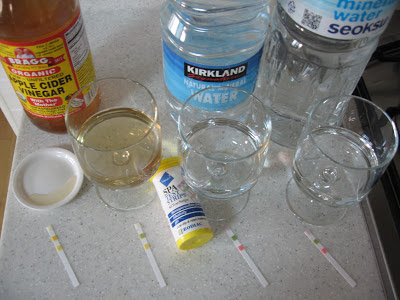After an extended vacation outside of Korea, I came back and didn't have any filtered water in my house to drink, so went to the supermarket and bought a couple of bottles, the brand Seoksu, since the "best" brand in Korea SamDaSoo wasn't available that day. Earlier in the year I had reacted to the water, with numbness in the head and arms, but I needed just a couple of bottles till I could get to a filter or get to Costco for the imported Kirkland brand, which doesn't bother me.
Well, I drank one glass of the Seoksu bottled water and my feet felt weird within seconds. I looked down and within five minutes my ankles had swollen. Needless to say, I didn't drink much of that water till I could get to the office filter the next day, but by the second glass my ankles were very swollen! That water must have had an instantaneous, and very scary, effect on my kidneys to get that kind of reaction. Thank goodness that within a few hours of drinking the filtered water, my ankles returned to normal.
So, using a couple of different water-testing spa kits, I thought I'd test the water of the two bottled waters, Seoksu and SamDaSoo (which also bothers me), just to "know" a bit more about them, I also tested straight Bragg's organic raw apple cider vinegar plus some pau d'arco made with Kirkland water and slow-cooked in the crockpot for a few hours. The raw apple cider vinegar is acidic, of course, but it supposed to have an alkalinizing effect on the body (like lemons and limes, according to the research) and the pau d'arco is a bark that is anti-fungal and who knows if it would interact and change the pH and other things of the water that was used to make it. TI should have tested the Costco Kirkland water without making it into a tea, but wasn't thinking. Ah well. The test is only for alkaline and acidity and doesn't find other minerals aspects or contaminants so it would only have been for very basic info.
Well, I drank one glass of the Seoksu bottled water and my feet felt weird within seconds. I looked down and within five minutes my ankles had swollen. Needless to say, I didn't drink much of that water till I could get to the office filter the next day, but by the second glass my ankles were very swollen! That water must have had an instantaneous, and very scary, effect on my kidneys to get that kind of reaction. Thank goodness that within a few hours of drinking the filtered water, my ankles returned to normal.
So, using a couple of different water-testing spa kits, I thought I'd test the water of the two bottled waters, Seoksu and SamDaSoo (which also bothers me), just to "know" a bit more about them, I also tested straight Bragg's organic raw apple cider vinegar plus some pau d'arco made with Kirkland water and slow-cooked in the crockpot for a few hours. The raw apple cider vinegar is acidic, of course, but it supposed to have an alkalinizing effect on the body (like lemons and limes, according to the research) and the pau d'arco is a bark that is anti-fungal and who knows if it would interact and change the pH and other things of the water that was used to make it. TI should have tested the Costco Kirkland water without making it into a tea, but wasn't thinking. Ah well. The test is only for alkaline and acidity and doesn't find other minerals aspects or contaminants so it would only have been for very basic info.






Comments
Post a Comment